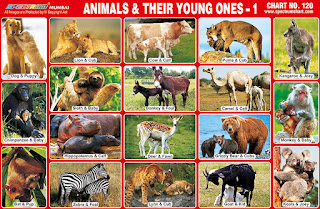Dog & Puppy : Dog - There are currently around 800
different species of domestic dog worldwide. Impact of dog on human
society has given them the nickname "man's best friend.”
Puppy - A dog is called a puppy until
it is about one year old. Puppies are highly social animals and
spend most of their waking hours interacting with either their
mother or littermates.
Chimpanzee & Infant -
Chimpanzee are thought to be the most intelligent animals on the
planet after humans. Chimpanzee is an omnivorous animal.
Infant – Chimpanzee are called
infants until it is about 5 years old. Upto the age of 5 – 6 years
infant chimpanzee are totally dependent on their mother.
Bat & Pup – Bats are
the only mammals that can fly. Bats are nocturnal. Bats live almost
everywhere, except the Arctic, Antarctic and a few oceanic islands.
They usually roost in caves, old buildings, or trees.
Pup - Pups are born without hair, they
look tiny, scrawny and pink. They are born with strong legs and
claws because they have to hang on to mom when she's roosting and to
the cave when she's not there.
Lion & Cub - Lions are
known as “King of the Jungle.” Currently they are found in only
two areas of the world, Asiatic lions live in India's Gir Forest;
African lions live in central and southern Africa.
Cub – Cub takes around 3 to 4 years
to be fully grown up. They achieve their hunting skills in 2 years.
Hunting skills are thought by their mother.
Cow & Calf - Cows are
raised as livestock for meat (beef and veal) & as a dairy
animals for milk and other dairy products.
Calf – Calf are born after 9 months
of gestation. They usually stand within a few minutes of calving.
Puma & Cub - Puma is a
large, secretive cat predominantly found in the mountains from
southern Canada to the tip of South America.
Cub - Pumas, cubs are born with
spots on their fur which helps them to be more easily camouflaged
from hungry predators. Puma cubs are born blind and are completely
helpless for their first two weeks of life.
Sloth & Baby - Sloths
are tree dwelling mammals that pass their time sleeping and eating.
The sloth happily eats both plants and insects, and occasionally
smallreptiles and birds.
Donkey & Foal - Donkey is known as a working animal.
Donkeys are used to be ridden, used for threshing, raising water,
milling and other work.
Camel & Calf - Camel is
known as a 'Ship of desert.' They are mostly found in deserts &
dry regions.
Calf – Calf are born after 13 months
of gestation. Camel calf takes about 3 years to be fully grown up.
At birth calf is about 3 feets long.
Hippopotamus & Calf -
The name hippopotamus means ‘river horse.’ Hippopotamuses spend
a large amount of time in water such as rivers, lakes and swamps.
Calf - Calf are born after 8 months of
gestation. Calf take about 7 to 8 years to be fully grown up. They
remain with thier mother until they are full grown up.
Deer & Fawn - Deer are
the ruminant mammals forming the family Cervidae. Deer have long
legs typically suited to the environments they live in.
Fawn – Gestation period for deer is
anywhere upto ten months. Most fawns are born with their fur covered
with white spots, though in many species they lose these spots by
the end of their first winter.
Bear & Cub - Bears are
large dog like mammals found all around the world. Most bears are
nocturnal & solitary animals.
Cub - Cubs are born toothless, blind,
and bald. They will remain with their mother for about three years.
Zebra & Foal - Zebra
has a unique pattern of black and white stripes. They are mainly
found in Africa.
Foal – Foal is born after a
gestation period of ten months to twelve months. Young Zebras remain
with their mother until they are mature at around three years old.
Lynx & Cub - Lynx is a
member of the cat family. They have short stubby tails and the long
tufts of black hair on the ear.
Cub – Cub is born after a gestation
period of 70 days. The young lynx cubs stay with the mother lynx for
around nine months.
Goat & Kid - Goats are among the earliest animals
domesticated by humans. Goats have been used for their meat, hair,
milk and skins.
Kid – Kids
most commonly arrive as twins. Sometimes just a single, but often
triplets are born. Goat kids learn to stand within minutes of being
born. At two weeks old, kids are fearlessly agile, running and
leaping for fun.
Kangaroo & Joey -
Kangaroos are marsupial animals that are found in Australia as well
as New Guinea. They have a deep pouch on their front in which they
carry their young ones.
Joey – They have the gestation
period of around 33 days only. At birth young ones are only few
centimetres long. It stays in the pouch of their mother for about
190 days from the birth.
Monkey & Infant –
Monkeys are arboreal mammals. Monkeys are intelligent, social
animals. They are famous for climbing trees easily.
Koala & Joey – Koalas
are herbivore marsupials that live in the eucalyptus forests of
eastern Australia. Koalas are often called the koala bears because
it looks like a small bear or teddy bear. However, it is not a bear,
it is quite a different type of animal.
Joey – Joey is born after the
gestation period of 32- 35 days. Joey upto 6-7 months lives in the
mother pouch. Having permanently left the pouch, it rides on its
mother's back for transportation, learning to climb by grasping
branches.


No comments:
Post a Comment